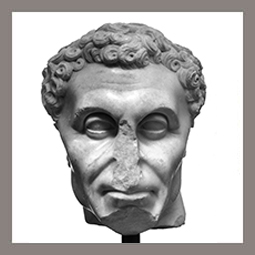Autore: R. Bucolo
Scarica l’articolo in formato .pdf: A Marble Head in the Ny Carlsberg Glyptotek of Copenhagen. Emperor Nerva’s Provincial Portraits between Sculpture and Coins
 L’articolo prende in esame una testa ritratto conservata nella Ny Carlsberg Glyptotek di Copenaghen che, stando alla documentazione del Museo, risulta proveniente da Rodi. Il ritratto è stato pubblicato fin dalla sua acquisizione e diversamente interpretato nel corso dei decenni. Inizialmente riconosciuto come raffigurante l’imperatore Nerva, in seguito è stato preferibilmente attribuito ad un cittadino privato della fine del I, inizio del II secolo d.C. L’opera, pesantemente polita in epoca moderna, presenta un volto e un’acconciatura peculiari. Proprio la particolarità fisionomica ha permesso di proporre un confronto con il ritratto di Nerva raffigurato sulle monete coniate a Rodi negli anni del suo breve regno. L’immagine di questo imperatore è piuttosto rara e presenta profonde variazioni a causa del massiccio riutilizzo di ritratti di Domiziano. Attraverso l’analisi di diversi media si propone una breve disamina della presenza e delle caratteristiche dell’immagine di Nerva nelle provincie dell’Impero.
L’articolo prende in esame una testa ritratto conservata nella Ny Carlsberg Glyptotek di Copenaghen che, stando alla documentazione del Museo, risulta proveniente da Rodi. Il ritratto è stato pubblicato fin dalla sua acquisizione e diversamente interpretato nel corso dei decenni. Inizialmente riconosciuto come raffigurante l’imperatore Nerva, in seguito è stato preferibilmente attribuito ad un cittadino privato della fine del I, inizio del II secolo d.C. L’opera, pesantemente polita in epoca moderna, presenta un volto e un’acconciatura peculiari. Proprio la particolarità fisionomica ha permesso di proporre un confronto con il ritratto di Nerva raffigurato sulle monete coniate a Rodi negli anni del suo breve regno. L’immagine di questo imperatore è piuttosto rara e presenta profonde variazioni a causa del massiccio riutilizzo di ritratti di Domiziano. Attraverso l’analisi di diversi media si propone una breve disamina della presenza e delle caratteristiche dell’immagine di Nerva nelle provincie dell’Impero.
The paper analyses a portrait head currently held at the Ny Carlsberg Glyptotek in Copenhagen, which, according to the Museum’s documentation, is probably from Rhodes. The portrait has been published since its acquisition and has undergone varying interpretations over the decades. Initially, it was identified as that of the emperor Nerva, but later, it was preferably attributed to a private citizen of the late 1st – early 2nd century AD. The heavily polished artwork has distinctive facial features and hairstyles. The physiognomic peculiarity provides a basis for comparison with the portrait of Nerva on coins minted in Rhodes during his short reign. The image of this emperor is rare, with significant variations due to the recutting of Domitian’s portraits. This paper provides a brief overview of the presence and characteristics of Nerva’s image in the provinces of the Roman Empire through the analysis of various media.
